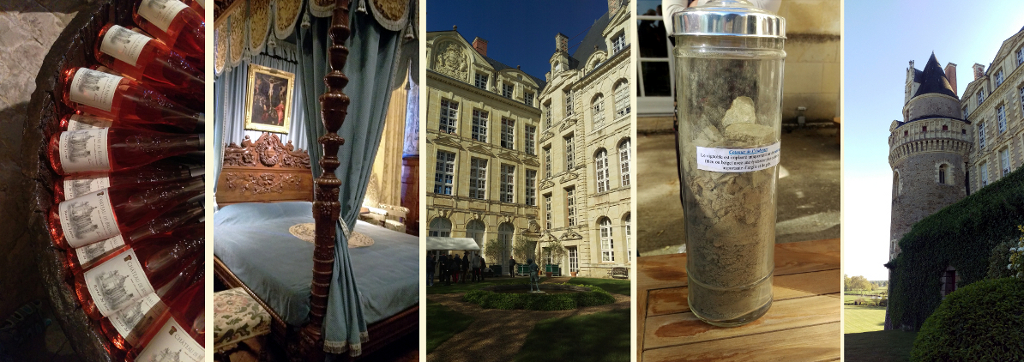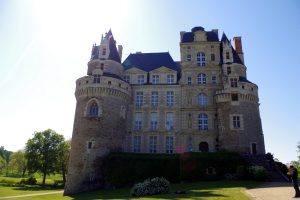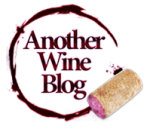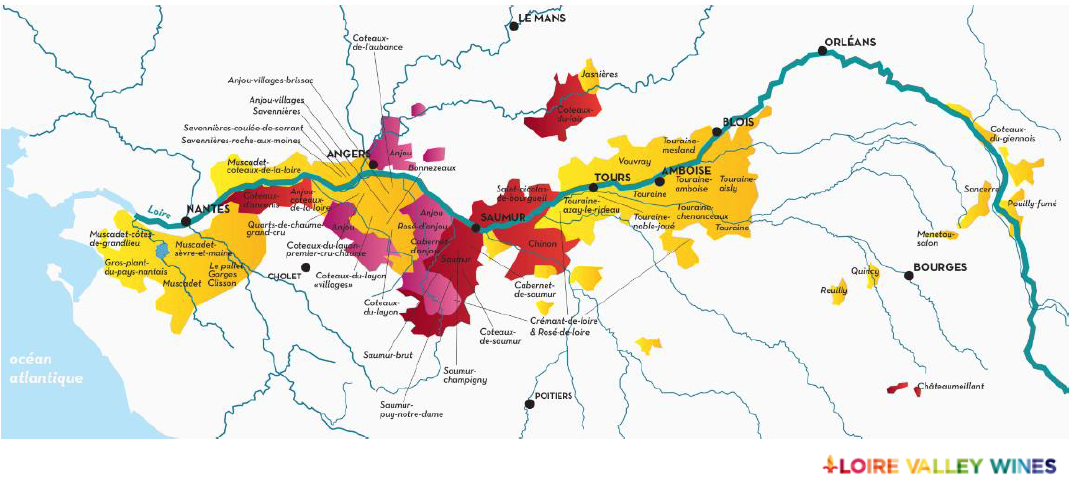No doubt you are aware Loire Valley Wines represent the top producer of white AOC wines, but did you know this important French wine region produces Reds, Rose and Bubbles in its 48,000 hectares of vineyards as well? Located in the heart of France, the Loire Valley’s 79 appellations and denominations employ over 5,000 professions who help produce and market an average of nearly 3 million hectolitres. The Loire Valley sells 380 million bottles of wine annually, making it the third largest AOC wine making region in the French economy. While much of the wine sells in France, Loire Valley producers export 68 million bottles to over 150 export markets around the world.
The longest wine route in France at 1,000 kilometres along the Loire River, the Loire Valley is a region rich in history and culture dating back to the Fourth Century when grape vines first appeared on the scene primarily near monasteries and Royal Courts. The largest UNESCO World Heritage site, Loire Valley climates are influenced by both the River and the Atlantic Ocean. Its soils are rich in diversity.
All About the Dirt
But why do these soils matter? Because soil is one of the chief components in grape growing, and knowing the soil lets us know which grapes tend to grow best. France recognized this with the development of the Appellation d'Origine Contrôlée (AOC) system, meaning “controlled designation of origin” created in 1936. France developed the AOC system as a certification method for wine’s geographic indication, but today the AOC designation extends to many other products, including cheese, butter and lavender. So just how do soils differ within the four main subdivisions of the Loire?
From the Nantes area, closest to the ocean, we find the volcanic rock of the Armorican Massif, gneiss and granite. From here comes the fabulous Muscadet that pairs so well with seafood.
Farther inland in the Anjou area, soils of schist and chalky limestone dominate. From this area comes Loire rosé, made from grolleau and gamay. The Loire is the second largest producer of AOC Rose wines, specializing in off-dry wines with rich aromas of fresh fruit and colors of fuschia and violet.
We tasted some of these Rosés after a horse-drawn carriage tour of the vineyard grounds, and a walking tour of Château de Brissac by the Marquis Charles-Andre de Brissac himself. The highest castle in all of France with its 204 rooms spread over seven floors, Brissac is a family-owned château, owned by the same family for over 500 years. First purchased in 1502 by the first lord of Brissac Rene de Cosse, the castle is now the home of the thirteenth Duke of Brissac. It contains a chapel, rooms with gold leaf ceilings and a Belle Époque theatre, dedicated to the opera.

Travel farther inland still, to find Tuffeau limestone, chalk-clay soils, sand and gravel in Saumur and Touraine. In Touraine we discover wines made from Sauvignon blanc, Chenin and Chardonnay, as well as the classic and elegant wine from Cabernet franc and Côt (known to us as Malbec) grapes. In Saumur we find many of the Loire’s sparkling wines made from Chardonnay and Chenin, and deep luscious and elegant Cabernet franc.
Farthest inland in Centre-Loire we find chalk-clay soils, sand and flint from which come Pouilly-Fumé and Sancerre both made from Sauvignon Blanc grapes.
Loire Valley is the top AOC sparkling wine after Champagne. Known as Fine Bulles, sparklers account for 19% of wines produced in Anjou-Saumur and 18% of wines produced in Tourraine. Sparkling wine pairs with everything, and is perfect for any occasion: weddings, graduations, holidays or simply to celebrate the day!
Among sparkling wines from the Loire Valley are Crémant de Loire and Saumur Brut. Crémant de Loire is made from a blend of several Loire Valley grape varieties, both red and white. Chenin blanc, Chardonnay, Cabernet Franc, Cabernet Sauvignon, Pineau d’aunis, Pinot noir and Menu Pineau are used and the deep black berries of Grolleau may be added as part of the blend, but each of the varieties is vinified separately. After blending and secondary fermentation in the bottle, the wines must age in the tufa caves for a minimum of 12 months. Saumur Brut earns its richness from white varieties of Chenin, Chardonnay and Sauvignon Blanc and red varieties of Cabernet Franc, Cabernet Sauvignon and Pineau d’aunis. These wines are made méthode traditionelle, much like Champagne: Wines are blended in early spring, then bottled with a mix of wine, sugar and selected yeasts. The wines undergo secondary fermentation in the bottle in the cellar. Bottles are riddled (regularly turned and tipped) for at least 9 months of maturation, then the bottle is disgorged to expel the sediment. A little sugar solution is added, and the bottle is recorked and labeled. Both Crémant de Loire and Saumur Brut should be serve chilled, between 7 and 8 degrees Celsius (44 – 46F) for Crémant de Loire and a bit colder (between 6 and 8 degrees Celsius) for Saumur Brut.
One of our favorite evenings in the Loire took place at Ackerman Caves. There we tasted sparkling wines with producers of the Unions des Maisons de Fine Bulles de Loire while enjoying hors d’oeuvres and dinner while one of the producers serenaded us. The celebration then took a magical turn as we followed a festive band of musical med students through the caves, complete with a fabulous string art installation, to reach dessert. If you have ever attended a Rice University Football game, the band of students reminded me a lot of the Marching Owl Band (M.O.B.) The short (just under 3-minutes) video below gives you a little flavor from the evening with pictures of some of the wines, the food, the art and the music.
Visit Loire Valley Castles and Caves
Château de Brissac offers tours to the public of the park, castle, the underground tunnel and the medieval kitchen. 
Hours: Château de Brissac is open every day during July and August from 10 a.m. to 5 p.m., 10 a.m. to 4:30 p.m. September and October, but close on Tuesdays and for lunch each day from 11:30 a.m. to 2 p.m. During the months of November through March during the French school holidays only, guests can take advantage of 2 guided visits at 2 pm. and 4 p.m. only. From April 1 through June 30, hours are from 10 a.m. to noon (last entry) and 2 p.m. to 5 p.m. (last entry) every day but Tuesday.
Rates: A visit to the castle, wine tasting and access to the park grounds and underground tunnel are 10 euros for adults and 4,5 euros for children aged 8 to 16. Children under 8 are free, and a reduced rate for students and disabled adults is 8,50 euro. A visit to just the grounds minus the Castle is 5 euros each. Guided visits take approximately 1 hour and 15 minutes.
Special Events: Château de Brissac also hosts a Christmas Market November 18 and 19th complete with Father Christmas and over 50 Christmas stallholders with goods for sale. In the Spring they host the Great Easter egg hunt, with over 50,000 chocolate eggs hidden in the gardens and undergrowth of the chateau.
For more information, please visit the website at http://www.chateau-brissac.fr/eng/opening-rates/
Ackerman Caves
The Caves are open every day except Christmas Day and New Year’s Day, generally from 9:30 a.m. to 12: 30 p.m. and 2 p.m. to 6:30 p.m. Monday through Friday, and opens one half- hour later at 10:00 a.m. on Saturday and Sunday. Tours are 5 euros each for anyone over 14 years of age, and guided tours from groups of 20 to 50 are 3 euros each, and available only upon reservation. Audio guides are available in French, English, German and Dutch. The site is equipped for handicapped visitors, and there is plenty of parking available on site. Please note the cellar is maintained at a constant temperature of 12 degrees C (54 F). For the most accurate information on times, exhibits and other special events during the year, please visit http://visite.ackerman.fr/en/practical-information/opening-hours/
Cheers!
The WineWonkette


